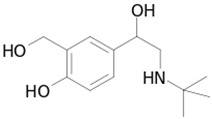Overview and History of Albuterol
Albuterol belongs to the sympathomimetic category of compounds (also known as stimulants). Albuterol is a selective beta-2 adrenergic agonist, and is a very close brother to the well-known Clenbuterol, and both hold the exact same roles in medicine (primarily for the treatment of asthma). However, Clenbuterol is primarily an internationally and European utilized asthma medication while Albuterol is exclusively used in the United States for the treatment as asthma, but is also readily available internationally as well. Other sympathomimetic stimulants of a similar nature include: Caffeine, Albuterol, Ephedrine, Dextroamphetamine, Methamphetamine, Cocaine, Epinephrine, Norepinephrine, and many others. These sympathomimetic stimulants will all serve to act upon the nervous system and various cells and tissues of the body by way of the alpha and beta adrenoreceptors. Albuterol is much like Clenbuterol whereby it is selective to exclusively act upon the beta-2 receptors in the body.
It is through this action that it is used as an ingredient in asthma inhalers, whereby it will exert activity directly on the smooth muscle of the bronchial pathways by way of interaction with the beta-2 receptors on the smooth muscle cells. The result is bronchodilation (the opening of the airways) so that the individual is capable of breathing once again following a spell of bronchial constriction or bronchospasm either due to asthma, allergy, or COPD (chronic obstructive pulmonary disease)[1]. Albuterol can also be administered orally, whereby it will then exert a systemic effect on the body but would take a longer period of time before exhibiting activity on the bronchial pathways, which is why for asthma patients, it is preferred to be administered via inhalation. It is the oral format that is the sought-after variant of Albuterol within the bodybuilding and performance enhancing drug world for its systemic effect on the body, which includes fat loss. The fat loss effect is achieved through Albuterol’s action upon the beta-2 receptors located on fat cells, whereby this interaction will initiate lipolysis (fat breakdown) and free fatty acids are mobilized and released from the fat cell for consumption by the body as fuel/energy[2].
It is interesting to note that Albuterol was actually the very first selective beta-2 adrenergic agonist to be marketed (even before Clen) in 1968 by Allen & Hanburys under the trade name Ventolin[3]. It was introduced to the American prescription drug market in 1980 and is the most widely used asthma drug in North America, and the brand name is still widely available in North America alongside many generic Albuterol products. Albuterol and Clenbuterol are very closely related, sharing almost the exact same chemical structure with a few differences. Albuterol differs from Clenbuterol in its half-life ( 4 – 6 hours versus 37 hours respectively), and in the intensity of some of its effects on the body in comparison to Clenbuterol, where many athletes and bodybuilders have reported that Albuterol is “milder” in various areas of effects than Clenbuterol is.
Aside from this, there are some other marked differences between Clen and Albuterol that should be made note of. The first is the fact that Albuterol has been clinically proven to be anabolic in muscle tissue in humans, as opposed to Clenbuterol which has only been proven to be anabolic in animals[4]. One particular study on human athletes who were chronically administered Albuterol demonstrated that the athletes increased maximal anaerobic power regardless of the training status of the athletes[5]!Even within animal studies, one study involving pigs administered Albuterol had demonstrated a 14% increase in muscle mass alongside a 25% decrease in fat mass[6]. Aside from this significant effect of Albuterol on muscle mass and fat loss, there are a plethora of studies on both humans as well as animals that have demonstrated a remarkable effect on fat loss[7] [8] [9] [10].
Chemical Characteristics of Albuterol
Albuterol belongs to the class of sympathomimetic drugs, and is known as a racemic drug. It is a fast acting beta-2 adrenergic receptor agonist that is very close in structure and relation to Clenbuterol.
Properties of Albuterol
Albuterol will exhibit a variety of effects on the body in different tissues by way of its interaction with the beta-2 receptors on the cells of those tissues. This will result in, as previously mentioned, fat loss, increase in metabolic rate, and slight anabolic effect in muscle tissue among other effects. The fat loss and slight muscle anabolism is what is highly sought after by athletes, bodybuilders, and general users of performance enhancing drugs. It is important to note that although Albuterol has been proven to be anabolic in humans, the muscle gains expected from Albuterol should not be the same as the anabolic gains and increases that are common of anabolic steroids, especially if the user is engaged in a caloric deficit for the purpose of fat loss. At best, in such a situation, Albuterol will assist in the preservation of muscle tissue during a caloric deficit rather than the significant addition of new muscle mass. Regardless, Albuterol is a very promising compound (perhaps more so than Clenbuterol) for the purpose of fat loss and/or slight muscle gain. It should be noted that anecdotally, many individuals who have experience with Clenbuterol will commonly claim that the fat burning properties of Albuterol are slightly less effective than its close brother Clenbuterol. Experiences may vary according to different individuals and users.
 Albuterol (AKA Salbutamol, Ventolin)
Albuterol (AKA Salbutamol, Ventolin)
Chemical Name: (RS)-4-[2-(tert-butylamino)-1-hydroxyethyl]-2-(hydroxymethyl)phenol
Molecular Weight: 239.311 g/mol
Formula: C13H21NO3
Original Manufacturer: Allen & Hanburys
Half Life: 4 – 6 hours
Detection Time: 48 – 72 hours
Anabolic Rating: N/A
Androgenic Rating: N/A
Albuterol References:
[1] “Albuterol”. The American Society of Health-System Pharmacists. Retrieved 3 April 2011.
[2] Comparison of the effects of salbutamol and clenbuterol on skeletal muscle mass and carcass composition in senescent rats. Carter WJ, Lynch ME (September 1994). Metab. Clin. Exp. 43 (9): 1119–25. doi:10.1016/0026-0495(94)90054-X. PMID 7916118.
[3] Ventolin remains a breath of fresh air for asthma sufferers, after 40 years. The Pharmaceutical Journal 279 (7473): 404–405.
[4] Drugs and sport. Research findings and limitations. P M Clarkson, H S Thompson. Department of Exercise Science, School of Public Health and Health Sciences, University of Massachusetts, Amherst, USA. Sports Med. 1997 Dec ;24 (6):366-84 9421862.
[5] Effects of short-term salbutamol ingestion during a Wingate test. Le Panse B, Collomp K, Portier H, Lecoq AM, Jaffre C, Beaupied H, Richard O, Benhamou L, De Ceaurriz J, Courteix D. Int J Sports Med. 2005 Sep;26(7):518-23.
[6] Eating quality of meat from pigs given the beta-adrenergic agonist salbutamol. Warriss PD, Nute GR, Rolph TP, Brown SN, Kestin SC. Meat Sci. 1991;30(1):75-80. doi: 10.1016/0309-1740(91)90036-P.
[7] Multiple symmetric lipomatosis (Launois-Bensaude syndrome): effect of oral salbutamol. Leung NW, Gaer J, Beggs D, Kark AE, Holloway B, Peters TJ. Clin Endocrinol (Oxf). 1987 Nov;27(5):601-6.
[8] beta2-adrenergic receptor polymorphisms and salbutamol-stimulated energy expenditure. Oomen JM, van Rossum CT, Hoebee B, Saris WH, van Baak MA. J Clin Endocrinol Metab. 2005 Apr;90(4):2301-7. Epub 2005 Feb 1.
[9] Reduction in visceral adiposity is highly related to improvement in vascular endothelial dysfunction among obese women: an assessment of endothelial function by radial artery pulse wave analysis. Park SH, Shim KW. Yonsei Med J. 2005 Aug 31;46(4):511-8.
[10] beta-Adrenergic stimulated lipolysis in pony adipocytes is exclusively via a beta2-subtype and is not affected by lactation. Carrington EF, Desautels M, Naylor JM. Comp Biochem Physiol A Mol Integr Physiol. 2003 Oct;136(2):311-20.





